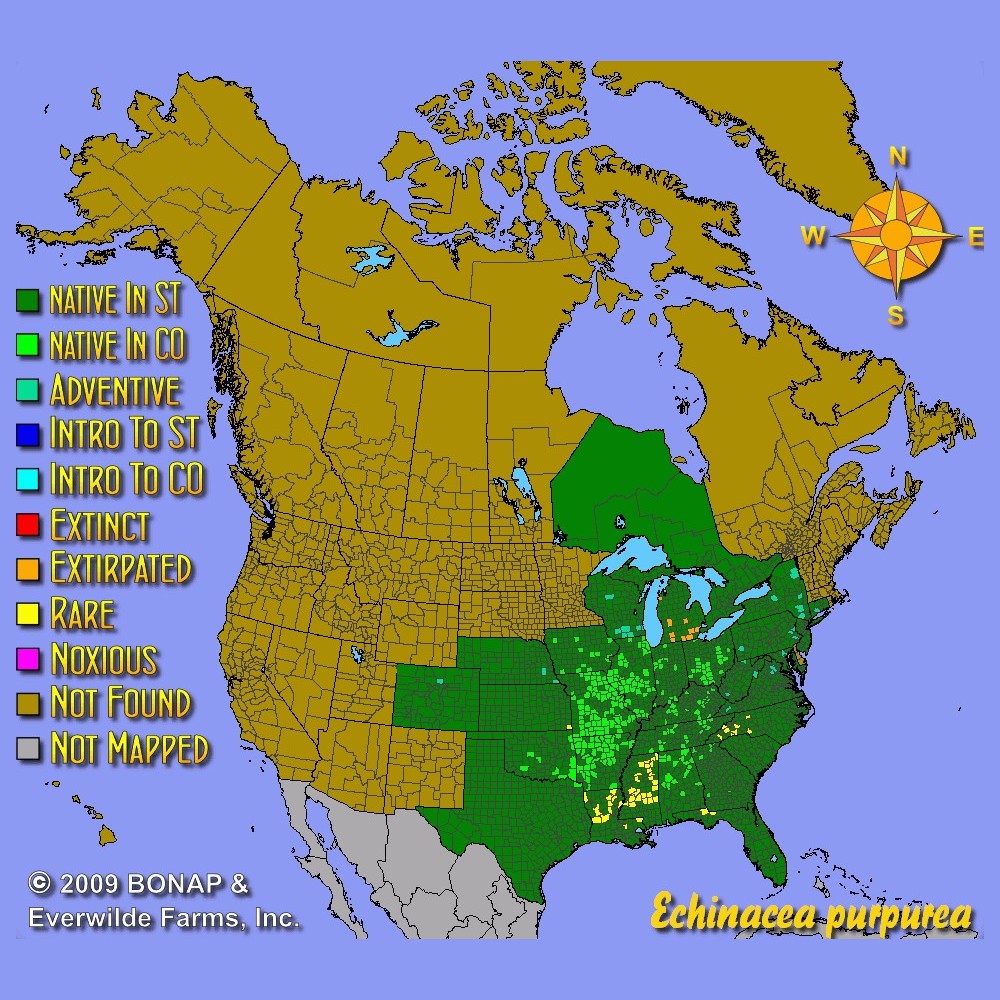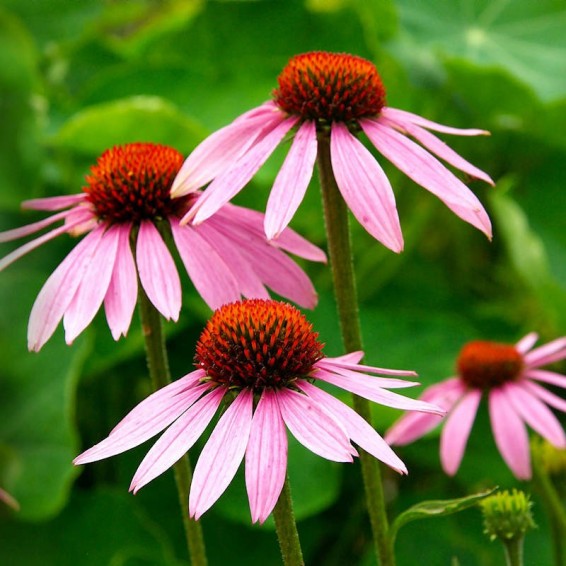Purple Coneflower Seeds
- HOW TO GROW
- FAST FACTS
- REVIEWS
HOW TO GROW
Sowing: Direct sow in late fall, planting the Purple Coneflower (Echinacea purpurea) seeds 1/4" deep and lightly compacting the soil. For spring planting, mix the seed with moist sand and store it in the refrigerator for 90 days before direct sowing; keep the soil consistently moist until germination. Thin or transplant the seedlings.
Growing: Water seedlings until they become established. Unlike most coneflowers, Purple Coneflower does not do well in drought conditions and needs adequate moisture. The area should be well-drained to avoid soggy soil, since this can cause disease. Keep competition to a minimum in the first year of growth, since this plant cannot reach its full potential when crowded by weeds. After several years of growth, mature plants can be divided in late fall. This Purple Coneflower plant attracts hummingbirds, butterflies and bees.
Harvesting: For fresh flowers, cut long stems of flowers that have just opened and place them in water immediately; strip the leaves that will fall below the water.
Seed Saving: After flowering, the central cones of the flowers will develop into a spiky seed head. Since songbirds such as goldfinches love to eat Purple Coneflower seeds, they should be harvested as soon as possible to avoid loss. As soon as the seeds easily come loose from the head, cut off the seed heads. Rub them lightly to remove the seed, and store the Purple Coneflower seed in a cool, dry place.
FAST FACTS
Common Names: Eastern Purple Coneflower
Latin Name: Echinacea purpurea
Species Origin: US Native Wildflower
Type: Native Wildflowers
Life Cycle: Perennial
USDA Zones: 4, 5, 6, 7, 8, 9
US Regions: California, Mountain, Arid/Desert, Plains/Texas, Midwest, Northeast, Southeast
Seeds per Ounce: 7,700
Stratification: No Stratification
Germination Ease: No Stratification
Sunlight: Full Sun, Part Sun
Height: 40 Inches
Color: Pink, Purple
Bloom Season: Blooms Early Summer, Blooms Late Summer
Uses: Attracts Pollinators, Attracts Honeybees, Attracts Butterflies, Hummingbirds, Cut Flowers, Deer Resistant
Purple Coneflower Seed Review
These seeds are a present for someone. These beautifully packed flower seeds make a really nice little gift for a friend who loves to grow flowers. Because the packaging is so beautiful, you don't need to wrap the seed packet. Get one of those "micro" bows if you want to give the package a little decoration.
Awesome flower
Well packaged. Quick shipment. I have used Everwilde seed before and have had good luck with the seed.
Trust Everwilde Farms
I completed a seed order from Everwilde then I saw these flower seeds and order them also. I sent a note to Everwilde saying i had two seed orders with two shipping fees. They deleted one of the shipping fees and sent both on one delivery. Nice move, Everwilde!
Happy Gardener
I ordered Purple Coneflower seeds for planting next year and I hope they do as well as the Pumila Zinnia seeds that I planted this year!
Great
Thanks
Great selection filters for native plants
I have been trying to grow native plants for the environmental benefits and to support insect and bird populations. You're website made it so easy to identify native flowers for my region. The growing tips are also much appreciated.
Excellent as Always
Excellent as Always. Super fast shipping. Love the packaging. I'll be back for more!
Wildflower seeds
So pleased to find a seed company with such a good array of California wildflower seeds.
They will be spread in a wildflower Meadow at our native garden. Can't wait till spring.
The seed packets are beautiful too.
Great
Happy
Had several my first year. They did great.
I LOVE EVERWILDE!!
I'm impressed
I'm impressed with the order so far. They shipped fairly quickly, and the seeds came in a nice resealable milar bag. Can't wait to plant them to see how they grow!
Good Ordering Experience at Website, NOT at Ebay
Your Ebay sales strategy is flawed and needs fixing. Otherwise, I love your company.
Purple Coneflower Seeds
Seeds arrive quickly and always very well packaged!
My garden
Great garden seed company, a favorite, with positive results!
DESCRIPTION

HOW TO GROW
Sowing: Direct sow in late fall, planting the Purple Coneflower (Echinacea purpurea) seeds 1/4" deep and lightly compacting the soil. For spring planting, mix the seed with moist sand and store it in the refrigerator for 90 days before direct sowing; keep the soil consistently moist until germination. Thin or transplant the seedlings.
Growing: Water seedlings until they become established. Unlike most coneflowers, Purple Coneflower does not do well in drought conditions and needs adequate moisture. The area should be well-drained to avoid soggy soil, since this can cause disease. Keep competition to a minimum in the first year of growth, since this plant cannot reach its full potential when crowded by weeds. After several years of growth, mature plants can be divided in late fall. This Purple Coneflower plant attracts hummingbirds, butterflies and bees.
Harvesting: For fresh flowers, cut long stems of flowers that have just opened and place them in water immediately; strip the leaves that will fall below the water.
Seed Saving: After flowering, the central cones of the flowers will develop into a spiky seed head. Since songbirds such as goldfinches love to eat Purple Coneflower seeds, they should be harvested as soon as possible to avoid loss. As soon as the seeds easily come loose from the head, cut off the seed heads. Rub them lightly to remove the seed, and store the Purple Coneflower seed in a cool, dry place.
FAST FACTS
Common Names: Eastern Purple Coneflower
Latin Name: Echinacea purpurea
Species Origin: US Native Wildflower
Type: Native Wildflowers
Life Cycle: Perennial
USDA Zones: 4, 5, 6, 7, 8, 9
US Regions: California, Mountain, Arid/Desert, Plains/Texas, Midwest, Northeast, Southeast
Seeds per Ounce: 7,700
Stratification: No Stratification
Germination Ease: No Stratification
Sunlight: Full Sun, Part Sun
Height: 40 Inches
Color: Pink, Purple
Bloom Season: Blooms Early Summer, Blooms Late Summer
Uses: Attracts Pollinators, Attracts Honeybees, Attracts Butterflies, Hummingbirds, Cut Flowers, Deer Resistant
Reviews
Review
Purple Coneflower Seed Review
These seeds are a present for someone. These beautifully packed flower seeds make a really nice little gift for a friend who loves to grow flowers. Because the packaging is so beautiful, you don't need to wrap the seed packet. Get one of those "micro" bows if you want to give the package a little decoration.
Review
Awesome flower
Well packaged. Quick shipment. I have used Everwilde seed before and have had good luck with the seed.
Review
Trust Everwilde Farms
I completed a seed order from Everwilde then I saw these flower seeds and order them also. I sent a note to Everwilde saying i had two seed orders with two shipping fees. They deleted one of the shipping fees and sent both on one delivery. Nice move, Everwilde!
Review
Happy Gardener
I ordered Purple Coneflower seeds for planting next year and I hope they do as well as the Pumila Zinnia seeds that I planted this year!
Review
Great
Thanks
Review
Great selection filters for native plants
I have been trying to grow native plants for the environmental benefits and to support insect and bird populations. You're website made it so easy to identify native flowers for my region. The growing tips are also much appreciated.
Review
Excellent as Always
Excellent as Always. Super fast shipping. Love the packaging. I'll be back for more!
Review
Wildflower seeds
So pleased to find a seed company with such a good array of California wildflower seeds.
They will be spread in a wildflower Meadow at our native garden. Can't wait till spring.
The seed packets are beautiful too.
Review
Great
Review
Happy
Had several my first year. They did great.
Review
I LOVE EVERWILDE!!
Review
I'm impressed
I'm impressed with the order so far. They shipped fairly quickly, and the seeds came in a nice resealable milar bag. Can't wait to plant them to see how they grow!
Review
Good Ordering Experience at Website, NOT at Ebay
Your Ebay sales strategy is flawed and needs fixing. Otherwise, I love your company.
Review
Purple Coneflower Seeds
Seeds arrive quickly and always very well packaged!
Review
My garden
Great garden seed company, a favorite, with positive results!






